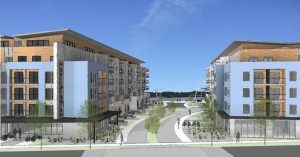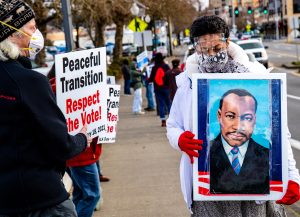Proposing a new “urban village”
As new “market rate” apartment buildings sprout up all over downtown Olympia, developers have set their sights on prime shoreline across the bay. What is more appealing to a well-heeled transplant than a view of sailboats and an iconic mountain with picturesque Budd Inlet for your front yard?
Developers Brandon Smith and Ron Newman have proposed a large-scale mixed-use project bordering the water on West Bay Drive, where Hardel manufactured plywood until its buildings burned down in 1996.

The promoters are calling their project West Bay Yards, “in tribute to our timber heritage.” “Yards” is the latest in trendy labels for such upscale “urban villages.” If the project comes to fruition, Olympia will join Camden Yards in Baltimore, Hudson Yards in New York City, Lincoln Yards in Chicago, and Dexter Yard in Seattle as “cities to watch.”
An economic magnet rising along the shore?
The sheer size and scope of such a project would make a significant change in the economic life of Olympia. West Bay Yards as proposed wouldn’t be a village, but a small town with a population exceeding that of many burgs—and an expectation to grow.
As Troy Nichols, the Phillips-Burgess spokesman representing West Bay Yards (WBY) told The Olympian: “Nothing happens without any economic impetus to get things going. If we’re ever to have a fixed and functioning West Bay, this the first step.” There’s already another proposal for a 40-unit apartment building across the road to the west.
Reviewing the specifics of the project
Over last summer and fall, the developer’s people spent time with the staff of the Community Planning and Development department (CP&D) laying out the specifics of the project. In addition to five apartment buildings with a total of 478 units, there would be new restaurant and retail opportunities, recreation facilities and offices. There would be parking stalls for 680 vehicles—with an expectation that the bulk of them could be underground. The proposal contemplated creation of an additional 1–1.5 acres of upland by adding new fill into the tidelands to achieve the density sought.
There were site maps showing vehicle access from West Bay Drive, an esplanade along the shore and an agreement that the developer would follow recommendations of a 2016 report on restoration of the “Hardel Reach.” There were construction sequencing documents and a shoreline restoration concept plan.
A useful tool for regulating phased projects
As these discussions wound down, the developer and city staff agreed that they would take advantage of a Washington law to give the West Bay Yards project certainty with a “Development Agreement” that would lock in current development standards for 15 years.
A “Development Agreement” is a binding contract between a city and a developer that specifies the obligations the developer has to meet, and ensures that new obligations will not be imposed on them during the term of the Agreement. In exchange, the developer includes in the project some public benefit that the city could not otherwise require. This might be infrastructure improvements, public open space, etc.
Development Agreements are reserved for major projects; they also serve as powerful tools that can give a city increased discretion when it comes to approving a development. To ensure against a blank check, Washington law requires every Development Agreement to specify standards, ranging from the very minimal to very complicated. It also requires that Development Agreements be presented at a public hearing before being submitted to the City Council for their evaluation and approval.
A project becomes a “non-project action”
The staff and WBY representatives wrote up a Development Agreement (DA) that had few particulars. Among other significant elements, it was missing “mitigation measures” required as part of the DA law. It confined itself to establishing “parameters and phasing schedule for future developments on the property” stating that everything in the Agreement was vested in the developer “under the Existing Land Use Regulations and may not be changed or modified by the City.”
The CP&D staff used the Development Agreement as the basis for completing a checklist whose purpose is to indicate whether there’s a need for a full environmental impact assessment under the State Environmental Policy Act (SEPA). By so doing, they turned the WBY project into a “non-project action.” Accordingly, they filled out the checklist for “The West Bay Yards Development Agreement” as a “non-project action.”
The determination of non-significance
Not surprisingly, the Agreement was found to have no meaningful environmental impact. The result: a DNS—a determination of non-significance. [See a description of Development Agreements and “non-project” vs “project” actions below.]
Notwithstanding the DNS, Washington law requires that Development Agreements be presented at a public hearing and reviewed for approval by City Councils. This is one of the few development decisions not delegated by Olympia’s council members to staff or an outside Hearing Examiner.
In November, the CP&D staff planned to recommend the Agreement to the Council. Pending the expected approval, the West Bay Yards project would go ahead under the Development Agreement. Findings of any subsequent environmental impact assessment could only be addressed within the terms of the DA. Instead, the train was stopped by a challenge to the “Determination of Non-Significance.”
Evaluating impacts “at the earliest possible point”
On December 1, the Olympia Coalition for Ecosystems Preservation (OCEP), appealed the Determination Of Non-Significance (DNS) arising from the Development Agreement.
When OCEP learned of the West Bay Yards’ proposed Development Agreement, they were alarmed. “A project with impacts as potentially massive as the one proposed on a contaminated shoreline of a waterway that does not meet water quality standards mandated under the Federal Clean Water Act cries out for a comprehensive environmental analysis.”
Spokesman Troy Nolan of Phillips Burgess defended the City’s handling of his client’s application, “They don’t make the [environmental] determination willy nilly,” he said. “The staff is thorough and fair and they do a good job.” (The Olympian, Dec. 8, 2020)
(Phillips Burgess’s role along with that of the Thurston Economic Development Council, the Chamber of Commerce and the City of Olympia Planning and Community Development Department, is to advocate for more development. OCEP’s role in the community is to advocate for Olympia’s remaining ecosystems.)
Leaving major environmental decisions to a private company
OCEP had important objections to the Development Agreement itself, including the fact that it relinquished to a private company some major decisions about water quality, shoreline habitat and public access that belong to the public. Even the provision in the Agreement that purported to offer an otherwise unattainable public benefit was hollow because it was actually in the city’s authority to require.
Other concerns involve the way the West Bay Yards proposal relates to Olympia’s Shoreline Master Program (SMP). The proposal appears to contradict the SMP goal of ensuring no net loss of shoreline ecological function and processes, as well as the prohibition against restoration projects creating additional upland area—something explicitly intended for the West Bay Yards development.
OCEP’s appeal calls for the Development Agreement to be replaced by a public SEPA scoping meeting.
This would initiate the environmental analysis of the project that is needed for staff, Counsel and community to make an informed decision on how to proceed.
“Existing environmental analysis of the area is limited and based on documents that are in some cases nearly 30 years old. No such analysis has contemplated a development on the scale proposed for West Bay Yards. No analysis—typically required in an environmental review of projects of unusual size and scope—has investigated alternatives.” (OCEP)
They point out that SEPA requires the environmental impacts of a proposal to be analyzed “at the earliest possible point in the planning and decision-making process, when the principal features of a proposal and its environmental impacts can be reasonably identified.” The specifics of the West Bay Yard project are well established.
OCEP has asked for summary judgment of their appeal. It will be heard by Chehalis attorney Mark C. Scheibmeir who occupies one of the two positions that the City Council hires (the other is City Manager). Depending on the Hearing Examiner’s decision on summary judgement, the outcome of the appeal might not be known until March.
Consulted for this article were the appeal filed by Olympians for EcoSystem Preservation and a description of the project by the Thurston Economic Development Council among other documents.
Bethany Weidner has lived in West Olympia and watched it evolve over the last 35 years.
The State Environmental Policy Act, Development Agreements and kinds of actionsDevelopment Agreements. RCW 36.70B.170 says a Development Agreement must set forth the “development standards” and provisions that “shall” govern and vest the development, use and mitigation of a proposed property. It goes on to say that “development standards” include a list of 10 things. Among the 10 are c) mitigation measures, development conditions and other requirements under RCW 43.21C—the State Environmental Policy Act; and d) such things as drainage and water quality requirements. Several examples of Development Agreements signed by other cities with their developers show up on the website of Washington’s Municipal Research Service Center. They suggest that Development Agreements are arrived at after an environmental assessment has been conducted. Project and Non-project Actions. Section 197-11 of the Washington Administrative Code sets the rules for SEPA, including a rule that defines what kinds of things are “actions” under Pathe Environmental Policy Act. There are two kinds of actions: project actions and non-project actions. Briefly, project actions are actions where an agency (like the City of Olympia) is making a decision on any activity that “will directly modify the environment, whether the activity will be conducted by the agency, an applicant, or under contract.” Non-project actions are where an agency is deciding on policies, plans or programs. The WAC specifies what these might be: adopting amendments to existing rules or regulations, etc., adopting or amending comprehensive land use plans or zoning ordinances and adopting a policy, plan or program that will govern a series of connected actions, and so on. All of these relate to broad determinations rather than to decisions on projects directly modifying the environment. |

Thank you for shining a light on this issue. It sounds like a rubber stamp process was at play here, given your reporting that the CP&D department essentially used the Developer Agreement itself as their “guide” and failed to do their actual job for the environmental impact assessment. Their having “determined” this to be a non-project action is very suspect, and I’m glad that they have been challenged on that point.
To whom would you recommend citizens contact to voice their concerns and demand a thorough and transparent review of the appropriate environmental impact assessment? I assume the City Council would be a start, but if there are any other avenues of getting involved, that would be good info to have.
This is a VERY bad idea. I will be requesting an environmental impact statement
The path to economic development should never include the inevitable destruction of the already sensitive ecosystems that need to be restored, not challenged. The additional traffic, light and noise is not conducive to a healthy life for the heron rookery and other shorebirds as well as human residents. And what have we already not learned about “filling in” the bay? And rising tide levels? The pollution from that many cars in a parking lot, that close to the water, should be enough of an alarm to halt or at least scale a “design” like this way down. This project is a very bad idea and would only profit the out of town development group behind it!
I am not in favor of this over-sized development along West Bay Drive. The Ecosystems that are being restored in have not been given any consideration. I believe the area will be ruined. Quality of our community continues to disintegrate. There is so much development going on downtown. Why can’t that be enough,